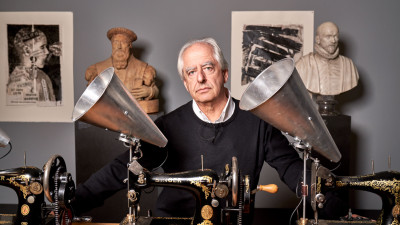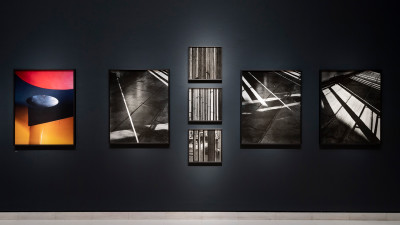Giovanni Battista Moroni: Cut from a different cloth
Giovanni Battista Moroni: Cut from a different cloth
By Sarah Dunant
Published 2 October 2014
One of the greatest of all portraitists, Giovanni Battista Moroni captured his sitters’ psychology with exceptional honesty and insight. As the Academy stages the biggest survey in Britain of the Renaissance painter’s work, novelist Sarah Dunant evokes the many characters who emerged from his canvases.
-
From the Autumn 2014 issue of RA Magazine, issued quarterly to Friends of the RA.
He is busy. Those heavy scissors in his hand are about to make a cut, the shape marked out, white chalk on black material, on the table in front of him (The Tailor, 1565-70). He has an honest face; handsome, yes, but open, engaged, not afraid to look his client – or whoever else walks into his shop – in the eye. If the clothes he produces are as substantial as his appearance, then he will make a decent living. No doubt he is pleased to be taken seriously by a professional artist. He is only a tailor after all, and not many such men in a small town in northern Italy in the 1560s and 70s have their portrait painted. But whatever the satisfaction, he will not, you feel, be able to pose for long. He has work to do and needs to get on with it.
Then there is the disgruntled old man, sitting in his chair, staring out at us (Old Man Seated with a Book, c.1570-75). Here is someone who has no need for our approval. Perhaps he was reading his book, or thinking about death, before he turned towards us; either way he seems to have little time or inclination to open up his soul to the brush of the artist. That grumpy expression on his face, as the art historian John Pope-Hennessy put it, “makes one wish one had knocked before entering the room.” We are already halfway to knowing him.
It is not only novelists like myself or art historians such as Pope-Hennessy who find the study of portraits so rewarding. Anyone who has seen the work of Giovanni Battista Moroni (and generations of visitors to the National Gallery will have been entranced by that tailor, who has been in the collection since the 1860s), will surely feel the same thing: that although the past may indeed be a foreign country with all the cultural strangeness and challenge that suggests, with the right guide and a little imagination it can offer up universal humanity alongside deeper, sometimes darker, individual psychology and character.
Born in the village of Albino, near Bergamo in Lombardy in the early 16th century, Moroni may not be as well known today as many other Renaissance artists. Indeed some art historians have been decidedly sniffy about his talent: Bernard Berenson dismissed him as “the only mere portrait painter that Italy has ever produced”, adding, “these people of his are too uninterestingly themselves”. But spend a couple of hours in Moroni’s company, as visitors to the Sackler Wing at the RA will do this autumn, and you will surely understand why over the centuries some of his canvases have been attributed to Titian. And Titian himself, older and always much more famous, is said to have rated Moroni’s work, recommending him to Venetian patricians, because, as he put it, he painted men ‘from nature’.
-

Giovanni Battista Moroni, Isotta Brembati, c.1555.
Oil on canvas. 160 x 115 cm. Fondazione Museo di Palazzo Moroni - Lucretia Moroni Collection, Bergamo. Photo: Fondazione Museo di Palazzo Moroni - Lucretia Moroni Collection. Photography: Marco Mazzoleni.
-
Painting from nature: it is a rich idea, suggesting truth over vanity, realism over artifice and man’s humility in the face of God as the ultimate creator. In Moroni you find all of those ingredients in different ways. While he can conjure up the silk of a woman’s dress so that the whole canvas glows with its warmth and wealth, he is not afraid to paint the men – or women – in front of him, warts and all, from choleric faces to scarlet, bulbous noses, an obvious mole on the cheek of a middle-aged woman or the facial cyst on the forehead of a doctor. Many of Moroni’s sitters come down to us with distinct physical personalities as well as psychological ones.
For most of his life, Moroni lived and worked within 35 miles of Albino. As a young man he moved to Brescia to study with the painter Il Moretto and when his master died in 1554, he settled in Bergamo, later moving back to Albino. This area of Italy was under Venetian control, with thriving local aristocracy and governors, and the wealth and visual ostentation of Venice was never far away. But it was also on the border with Milan, for many years ruled by the Spanish, and by then in the throes of the Counter Reformation. While we know tantalisingly little about Moroni’s personal life, the interaction of those two cultures finds its way into his work.
For many years he is, in effect, Bergamo’s equivalent of a court painter, and his full-length, life-size portraits of the city’s aristocracy show that he can fashion shoot with the best of them, using his brush like a needle on embroidered cloth, painting a feather fan so soft your fingers itch to touch it (Isotta Brembati , c .1555), or creating a chain mail jacket where you feel the weight of every link (Faustino Avogadro, c .1555-60). That latter portrait, also known as A Knight with his Jousting Helmet (The Man with the Wounded Foot) , does not flinch from showing a brace on the sitter’s left leg, the scattered armour offering a more poetic explanation of what we now know was the deformity the sitter had from birth. There is a certain mischief here, with the jaunty feathers of a stack of hats mirroring tufts of weeds growing from the stone behind him.
-

Giovanni Battista Moroni, Portrait of a Gentleman and His Two Daughters, c. 1572-75.
Oil on canvas. 125 x 97 cm. National Gallery of Ireland, Dublin. Photo © National Gallery of Ireland, NGI.105.
-
The object of court painting, of course, was to immortalise through status as much as likeness. How ironic then, that the most memorable people in Moroni’s work, and in the exhibition, come from more modest means. Following a factional murder in Bergamo which caused a crackdown by the Venetian state on the city’s noble families, Moroni went back to Albino after 1563 and the work that came out of his studio there, which includes the portrait of the tailor, is remarkable.
Most of his sitters presented themselves, to the world and to him, in sombre dress. This was not simply lack of wealth. Black was the colour of the professional – the lawyer, the cleric, the doctor, the magistrate, the scholar – whose dress identifies them as people of mature judgement. Of course, there was another, albeit more subtle, propaganda going on; they too aspire to status and Moroni doesn’t let them down. They look like serious men (the same is true of his portraits of women). But they also look like themselves.
There is an unguarded quality in these faces, as if – even when they appear grumpy – they have nothing to hide from the man studying them. In some cases it is clear that Moroni knew his subject. Albino was a small community; the doctor with the cyst on his forehead, for instance, is fingering a letter with Moroni’s name on it in Portrait of a Doctor (The Magistrate), from 1560. There is a similar informality to the settings. A simple, wooden chair features in a number of his works and canvases are smaller, half- or three quarter length. As the exhibition’s curator, Arturo Galansino, points out, while this was partly a commercial decision – a less expensive format for a more modest clientele – it also allowed the sitter’s faces to become more dominant. Moroni, it seems, made virtually no preparatory sketches (the only one we have is in the exhibition) so that his first impressions of a personality went straight onto the canvas.
-

Giovanni Battista Moroni, Portrait of an Elderly Man Seated with a Book (Pietro Spini?), c.1575-79.
Oil on canvas. 98 x 80 cm. Accademia Carrara, Bergamo. Photo: Comune di Bergamo-Accademia Carrara.
-
With black as the uniform, colour now becomes a kind of emotion. In The Widower (c. 1570), the subject’s grief and solemnity are emphasised by the bright orange and red outfits of his children as they huddle in his protective arms. The sitter in Portrait of a Man with a Red Beard (c .1558-59) seems as playful and good-natured as his untamed facial hair. And finally, in works such as Portrait of the Lady in Black (c .1572-73), there is the dramatic contrast of black against starched white cuffs and ruff collars, a Spanish style that took Europe by storm around the middle of the 16th century.
This is more than just fashion. It also reflects undercurrents in religious culture. Living on the edge of Milan, Moroni couldn’t help but be drawn into the Counter Reformation. We know that he attended the first two sessions of the Council of Trent and went on to execute a number of religious commissions in the new style decreed by the Church in readiness for the visit of Cardinal – later Saint – Charles Borromeo of Milan. Visitors to the RA show will be surprised by the rigidness of composition in his altarpieces, though at the time such lack of complexity in favour of didactic clarity would have made them the height of fashion. So too would his sympathetic paintings of men and women imagining religious scenes, such as A Gentleman in Adoration before the Baptism of Christ, (c.1555-60), which illustrated the latest method of devotion based on Ignatius of Loyola’s spiritual exercises. In contrast Venice, with its historically greater independence from Church government, was still wallowing in doctrinal laxity: think of the sumptuous decadence of Veronese’s biblical settings, shown this year at the National Gallery, and how when the local, comparatively toothless, Inquisition accused him of filling one canvas with “jesters, drunks, heretics and midgets”, Veronese changed the title of the painting rather than the image itself.
But there is another layer to Counter Reformation doctrine on art that, in Moroni’s hands at least, proved more freeing. Although Moroni died in 1579, three years before Cardinal Gabriele Paleotti’s Discourse on Sacred and Profane Images was published, he would certainly have been aware of the issues around portraying real people, with painters soon to be instructed by Paleotti “not to depict the face or any parts of the body as more beautiful than in real life”. In Moroni’s hands, this honesty becomes a kind of vivacity. One of the great pleasures of the exhibition is the way it represents churchmen.
-

Giovanni Battista Moroni, A Gentleman in Adoration before the Baptism of Christ (detail), c.1555-60.
Oil on canvas. 112.8 x 104 cm. Gerolamo and Roberta Etro. Photo Gerolamo and Roberta Etro..
-
There are two splendid portraits of monks (saved from black by the nature of their order) both seen close up, and both bursting with life, faces mobile and eager, filled with kindness, and even, it seems, a sense of humour. Although the Counter Reformation may not go down well in history, these men’s faith seems to make them more human.
Then there are the women. For a historian and novelist like myself, looking to breathe life into Renaissance women as well men, art is a problem as well as a source. History, on and off the walls, favours men and those women who do manage to be represented are too often defined by their beauty, sexuality and status, leaving precious little room for subtler characterisation. Moroni, however, gives us some wonderfully rounded personalities. There is a stunning study of contrast in Portrait of the Lady in Black (think Ingres, think Whistler). The lady in question might once have been a beauty, but those huge dark eyes speak more of experience and quiet authority. Like many of his sitters, she is busy, her index finger in the book she holds to save her place: whatever her past she also has a future to get on with.
And finally there is the portrait of the abbess. Be warned: she is not an inviting figure. Nuns are a strange lot in Renaissance culture. While they tell a history of social control – too many girls in an era of expensive dowries who have been married off to Christ – there is little sense of individual character to be found in any artistic representations. Moroni’s abbess (Portrait of Abbess Lucrezia Agliardi Vertova, 1557) is an exception. The inscription in the painting tells us she is a widow who is founding a convent. Certainly she has no problem being seen as old or even disfigured (let’s hope the convent doctor keeps an eye on the goitre in her neck). She has her eyes on something more important: her new responsibilities and the journey to God’s grace. Look closer and there is an intensity, even a slight sadness to her, as well as a touch of artistic affection: the way that densely wrinkled face echoes the fine crinkles in her veil. Strong minded? Certainly. Formidable? Possibly. But her refusal to be prettified or patronised gives her a sense of self as real as that grumpy old man staring back at us.
In the end, perhaps it is Berenson’s insult that best pinpoints the power of Moroni. ‘These people’ of his are indeed ‘themselves’, but does that really make them ‘uninteresting’? Or might it be that it is their very ordinariness that keeps us looking?
Back to the tailor: we will never know who he was, or how and why he came to be painted, but there is more than enough in the portrait to get our imaginations going. By all means enter the exhibition as a discerning observer of art, but throw in a touch of the novelist too. I promise it will be a worthwhile combination. And once you have given imaginative lives to Moroni’s sitters, try staring out from their eyes, to the painter himself. We need to know more about him.
Giovanni Battista Moroni is in The Sackler Wing at the RA from 25 October – 25 January 2015.
Sarah Dunant is a novelist, historian and broadcaster.
-
-
Enjoyed this article?
Become a Friend to receive RA Magazine
As well as free entry to all of our exhibitions, Friends of the RA enjoy one of Britain’s most respected art magazines, delivered directly to your door.
Why not join the club?

-








